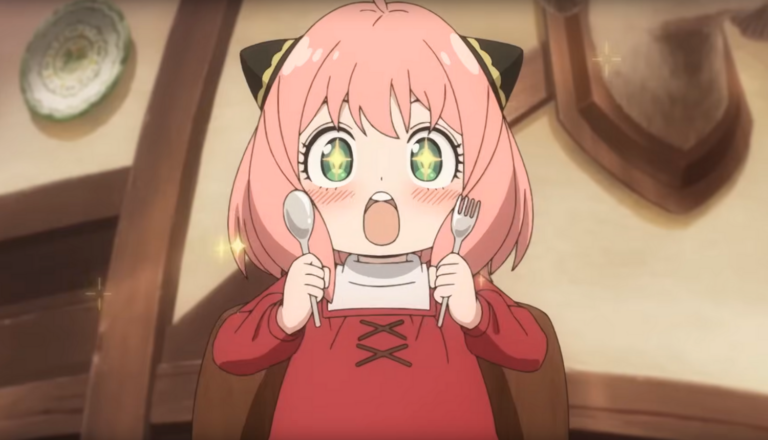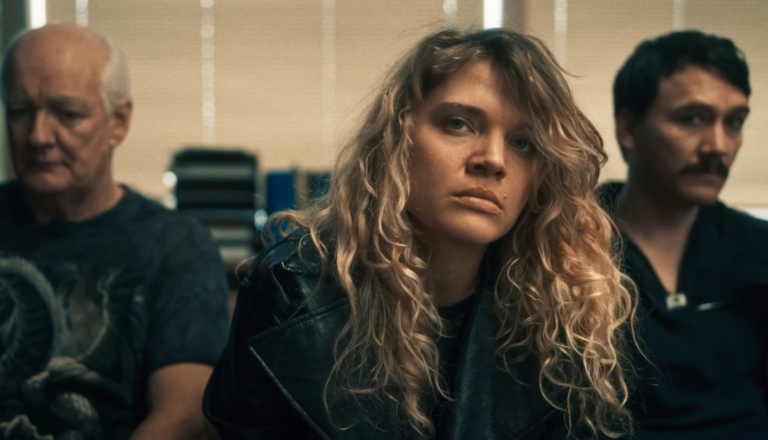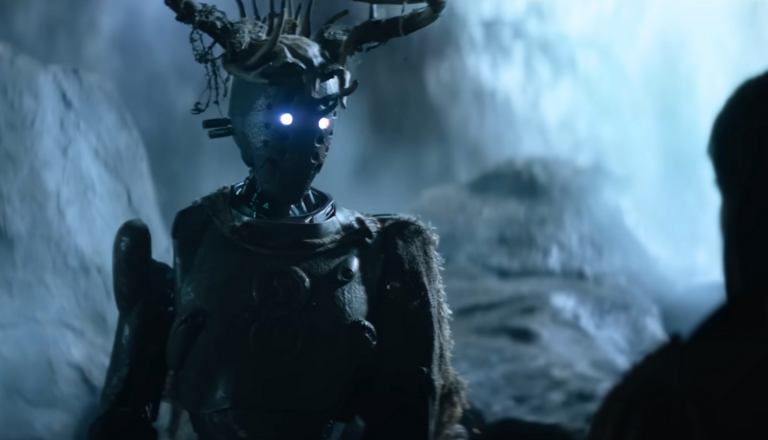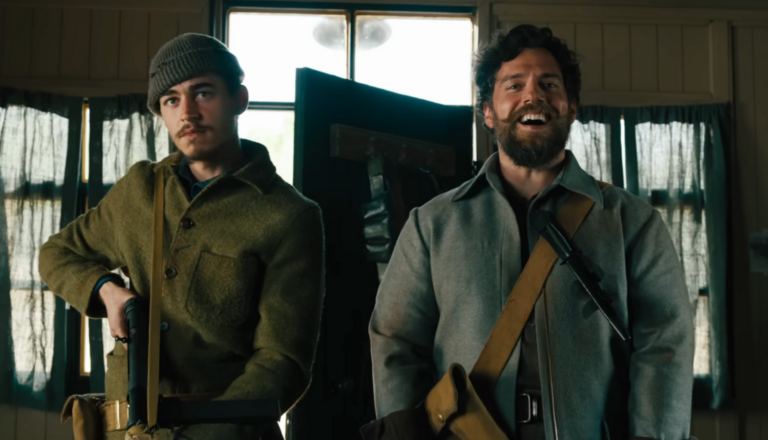Notice: All forms on this website are temporarily down for maintenance. You will not be able to complete a form to request information or a resource. We apologize for any inconvenience and will reactivate the forms as soon as possible.
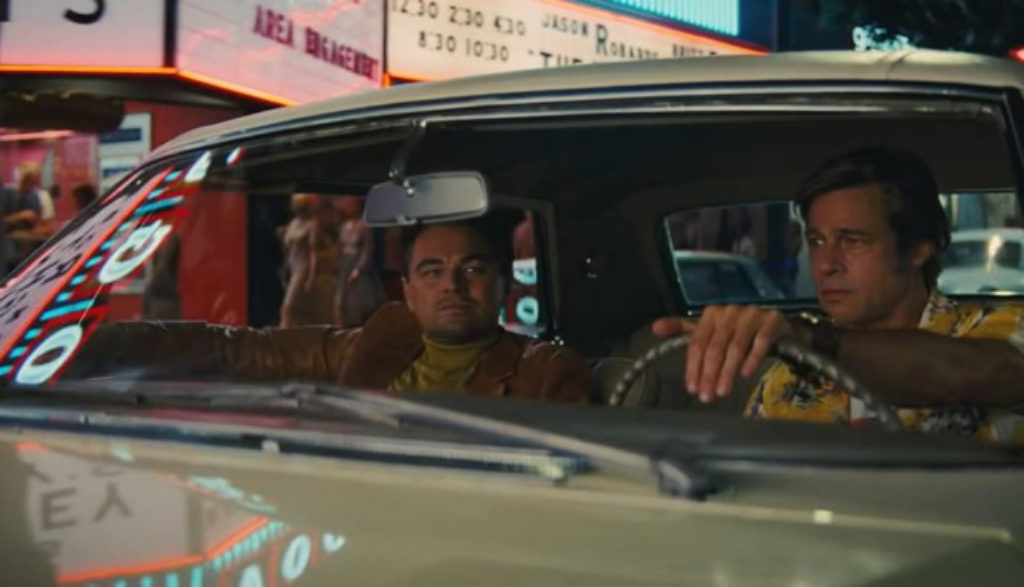
Credits
In Theaters
- July 26, 2019
Cast
- Leonardo DiCaprio as Rick Dalton; Brad Pitt as Cliff Booth; Margot Robbie as Sharon Tate; Emile Hirsch as Jay Sebring; Margaret Qualley as Pussycat; Timothy Olyphant as James Stacy; Austin Butler as Charles "Tex" Watson; Dakota Fanning as Lynette "Squeaky" Fromme; Bruce Dern as George Spahn; Al Pacino as Marvin Schwarzs
Home Release Date
- December 10, 2019
Director
- Quentin Tarantino
Distributor
- Sony Pictures
Reviewer
Movie Review
Real stars shine for eons. The ones that populate Hollywood’s hills? Not so much.
Rick Dalton gets it. Not so long ago, he was one of the city’s rising—and literally shooting—stars. He fronted a handful of Westerns as a Colt-twirling good guy. He landed in the occasional World War II flick, burning Nazis to ash with his trusty flamethrower. Then he moved to television, starring in a successful NBC’s Western: Bounty Law.
That was eight years and ever-so-many whiskey sours ago. It’s 1969 now, and Bounty Law’s gone. And while Rick still lands roles on the small screen, more often than not it’s as a guest-starring heavy: the villain the show’s star beats up or kills before the credits roll. For Rick, it’s just another part among many. But the subconscious message to audiences is clear: Dalton’s done. His career’s taking a beating every week.
An agent suggests that Rick’s only path back to relevancy is through Italy. But Rick’s skeptical. “Nobody likes Spaghetti Westerns,” he tells his best friend Cliff Booth.
If Rick’s a has-been, Cliff’s a never-was. For years he worked as Rick’s stunt double, and that paid well enough. But jobs dried up after Cliff killed his wife (or so they say). The film industry is pretty understanding, but even studio execs have their limits. Now Cliff’s less a stuntman and more a man Friday—chauffering Rick to jobs, fixing his television antenna, swilling down a few drinks with his pal when the need arises.
And so they sit in Rick’s house—a property he bought in healthier, happier times—and down glass after glass, recalling a brighter past and desperately imagining a better future.
But while one star sets on Cielo Drive, another rises.
Director Roman Polanski lives right next door, fresh off the success of Rosemary’s Baby. He roars through the gate in his convertible roadster, his beautiful wife—rising actress Sharon Tate—at his side. They’re Hollywood’s newest luminaries, invited to the hippest parties and welcome at the hottest clubs. Rick knows that if he could just get through that gate, he just might give his career new life.
Maybe.
But in 1969, the universe of Hollywood is a mighty unsettled place. Its Golden Age was winding down. A new, brasher, brassier age is just beginning. Barefooted hippies stand on street corners pushing peace and love and drugs. Vietnam rages. Society roils.
And somewhere deep in those hills outside Hollywood, on a near-deserted movie ranch, Charles Manson and his “family” of followers eat and drink and sing and plot and sharpen their knives. Hollywood might be changing, but not fast—and not violently—enough. Time to bring some chaos into its orbit. Some carnage. Some darkness.
And what better way than to pull down a star or two?
Positive Elements
Yes, Rick has a serious drinking problem. And sure, maybe Cliff killed his wife. But you can’t fault these two for their friendship.
If Cliff depends on Rick monetarily (which he does), Rick depends on Cliff for everything else. When Rick needs to go somewhere, Cliff drives him. When Rick needs something around the house, Cliff fixes it. And most importantly, when Rick needs encouragement, Cliff offers that, too—not some smarmy platitudes but sincere, genuine confidence in Rick and his abilities. Rick needs that more than anyone but Cliff knows.
But Rick doesn’t just repay Cliff with a nice check every couple of weeks: He tries to help him get work on movie sets, too. When the film industry turned its back on Cliff, Rick stood by his pal—and he’s willing to push others to give the guy a chance.
When one of Manson’s disciples brings Cliff to Spahn Ranch, the mostly deserted movie lot where the Manson Family squats, Cliff insists on checking in on George Spahn, an old friend of his who owns the place. It’s a pretty scary situation: Manson’s followers—though not openly homicidal just yet—outnumber the solitary stuntman about 20 to one, and they clearly don’t want Cliff talking with George. But Cliff insists, making sure that his 80-year-old friend is not being abused or kept against his will.
Spiritual Elements
When some of Manson’s disciples break into a Cielo Drive house and threaten its residents, one of the assailants says that he’s “the devil, and I’m here to do the devil’s business.” (And that’s exactly what one of the real Manson Family killers said before murdering several people on Cielo Drive.)
We hear an ad for Heaven Scent fragrances and a reference to Hell’s Angels. And, naturally, we hear a couple of references to Polanski’s movie Rosemary’s Baby, a horror flick in which a young woman is impregnated by the devil.
Sexual Content
Manson’s family is made up almost entirely of young women. One of them, who goes by the name Pussycat, takes a serious shine to Cliff. Dressed in a revealing knit halter-top and short cutoffs (which the camera often zooms in on deliberately), Pussycat flirts with Cliff from a street corner a couple of times before Cliff finally offers her a ride. Once in the car, she asks if he’d like her to perform oral sex: He asks Pussycat for some proof that she’s over 18, which she doesn’t have, so he refuses her advances. No matter: She stretches across the front seat and lies languidly in his lap, clearly still hoping to seduce the stuntman. Pussycat’s name predictably inspires one or two sexually suggestive quips.
Manson’s other disciples, both at the ranch and on Hollywood’s steamy streets, are often dressed in outfits that show plenty of cleavage, midriff and leg. One Family member, Squeaky Fromm, tells Cliff that she recently had sex with the ranch’s owner (and thus forced the 80-year-old to take a long nap).
We see several women in relatively modest bikinis and other skin-showing outfits, and Cliff strips off his shirt to work on a television antenna. A party takes place at Hugh Hefner’s Playboy Mansion, and we see bunny-clad young women serve drinks and dance. Several revelers wear swimsuits. Couples kiss. We hear some crass slang referencing various body parts.
At the party, we learn that Sharon Tate has a “type”: “Cute, short, talented guys who look like 12-year-old boys.” Polanski fits the template, as does former lover Jay Sebring. Sebring still hangs out with both Tate and Polanski: While one might jump to the conclusion that they’re in some sort of sexual threesome, the movie steers us away from that assumption, suggesting instead that Jay’s just a close (if oddly intimate) friend of Sharon’s. It also implies that if Polanski messes up his relationship with her, he’ll be there to step in.
Violent Content
When Rick sits down with a would-be agent, the agent tells the aging actor that he spent an evening watching a couple of Rick’s old movies—including a very violent war pic. He loved all the killing, the agent says.
“A lot of killing,” Rick admits with a sheepish smile, recalling a scene in which he immolated a half dozen Nazis with a flame-thrower. “Lot of killing.”
Once Upon a Time … in Hollywood doesn’t have as much actual killing as Rick’s old flick did. But the deaths and injuries we do witness are far more graphic.
One person takes another by the hair and smashes her head and face repeatedly into walls, fireplace mantels and the floor until she’s dead and, frankly, unrecognizable. Another is beaned with a can of food that graphically bloodies and caves in the person’s face. A dog tears into a couple of people, mauling them horribly. Someone dies after being set alight in a swimming pool. A man is skewered by a knife in the leg. Another is repeatedly punched in the face, leaving it seriously bloodied.
We see plenty of movie-in-the-movie deaths, too. In an episode of the 1960s show FBI, Rick’s character guns down a couple of soldiers. (Blood flecks their faces and clothes.) Cowboys get gunned down in the streets and fall off rooftops. In character, Rick threatens a little girl and throws her to the ground. (The girl actor—she doesn’t like to be called “actress”—pops up after the take and proudly says that she throws herself to the ground all the time, just for fun.)
Cliff fights a preening martial arts legend in a best two-out-of-three knockdown contest. One gets kicked in the chest. Another is thrown into a car (leaving a pretty serious dent). The two grapple in a short hand-to-hand sequence before it’s put to a stop. Rick threatens himself, in a mirror, saying that if he doesn’t learn his lines, he’ll kill himself.
When some Manson Family members wax a little nostalgic over the old TV shows they used to watch as kids, one recalls a drug-fueled musing she had: Every television show except I Love Lucy was predicated on murder, she insists. She exhorts her friends to “kill the people who taught us to kill.”
Someone pounds on a dog’s head, trying to get it to stop mauling. A rat, caught painfully in a trap, squeaks pitifully.
Crude or Profane Language
About 115 f-words and more than 40 s-words. We also hear “a–,” “b–ch,” “b–tard,” “d–n,” “h—,” “pr–k,” “p-ss” and “crap.” We see crude hand gestures. Police are called “pigs.”
Drug and Alcohol Content
Cliff buys a cigarette laced with LSD, which he keeps for several months before smoking. (Once he does, the drug-laced cigarette messes him up something serious.) It’s not the only illegal substance imbibed. Several people smoke marijuana, and one fellow rolls a hefty joint.
Many characters, including Rick and Cliff, smoke tobacco, too—mostly cigarettes. They smoke so much that, when one opens a car door, he pushes several butts to the ground on his way out. During the closing credits, Rick peddles Red Apple cigarettes via a black-and-white commercial (the brand being a regular Easter egg in Tarantino’s films). But during the film itself, we see indications that smoking these and other unfiltered cigarettes has likely taken a serious toll on the guy’s health. He coughs and hacks frequently, sometimes spitting out gunk (much to the disgust of a young co-star of his).
All that said, alcohol is far more pervasive here. And in Rick’s case, it’s more problematic.
Cliff and Rick don’t seem overly picky about what sort of alcohol they pour into their bodies, but they do have some personal preferences: Cliff drinks a couple of Bloody Marys, while Rick downs several whiskey sours. In fact, one evening before an important TV appearance when Rick’s supposed to be learning his lines, he downs eight glasses of his favorite drink—a common nightly intake, the film suggests. And when Rick forgets his lines the next day, he bitterly and profanely chastises himself for his stupidity and drinking. He promises himself he’ll never drink again—a second or two before he takes a swig from a flask he always keeps handy. (He does seem to throw the alcohol away thereafter, but later scenes confirm that his commitment to sobriety was a fleeting one.)
Rick sips from a flask elsewhere, too. At one point he guzzles margarita mix straight from a blender. We learn that Cliff drives Rick everywhere because Rick lost his driver’s license following one too many DUI arrests. Other people drink too, of course: Late in the movie, Rick and Cliff make an unspoken commitment to get completely wasted to commemorate a life change. Lots of beer is consumed, too. Cliff even sticks one in his tool belt when he goes to the roof to fix an antenna.
Other Negative Elements
Los Angeles is notorious for its terrible traffic and bad drivers. If Los Angelinos drive like Cliff drives in the movie, that reputation is well-earned.
We hear some racist attitudes, and hippies display a distinct lack of respect for authority (particularly policemen).
Conclusion
Director Quentin Tarantino is widely regarded as one of Hollywood’s best directors. His dialogue crackles like bacon on a grill. He structures his stories like a gifted but slightly mad architect. He draws A-list talent to his movies and teases out some remarkable performances from them.
That makes Tarantino’s obsession with blood and gore just that much more disappointing.
Once Upon a Time … in Hollywood ushers us into the last light of Hollywood’s Golden Age—romanticizing it, glorifying it and sullying it in equal measure. In one act, the film brilliantly juxtaposes Rick’s battle for self and soul in a make-believe Western while Cliff takes a turn as a sunglass-wearing Gary Cooper, facing down the Manson clan in a dusty, rundown Old West facsimile—a dizzying blend of homage and subversion and ironic critique of the most American of movie genres. Then, not much later, he gives us an extended scene where a dog nearly tears off someone’s genitals.
This is not to say that Tarantino’s blood-saturated revenge fantasies are without meaning. There’s a whiff of Old Testament judgment contained in much of Tarantino’s work: Jael driving a stake into the head of a Canaanite general. But Tarantino takes such absolute, adolescent joy in his bloody excesses that I sometimes want to take a shower after reviewing his films.
At this point, Quentin Tarantino is a known quantity. His fans know what to expect. His detractors know to stay away. So interestingly, Once Upon a Time … in Hollywood feels, by Tarantino’s standards, more restrained than some of his work—certainly more so than his last blood-bathed-and-baked film, The Hateful Eight. But this one’s better only by that dim comparison. By most other standards, this is as bloody and messy as a butcher’s hand-me-down apron.
This is Tarantino’s ninth film. He swears that he’ll only make 10 before he turns off his camera and retires. And honestly, I’m a little sad about that.
Here’s why: With just one film left to go on his career docket, I doubt he’ll let go of his gore-encrusted crutch to really explore the depths of his skill, to craft a film that does away with it’s unnecessary flotsam of shock and become the storyteller he could really be.
But he, like the mauling dog in this film, just won’t let go.


Paul Asay
Paul Asay has been part of the Plugged In staff since 2007, watching and reviewing roughly 15 quintillion movies and television shows. He’s written for a number of other publications, too, including Time, The Washington Post and Christianity Today. The author of several books, Paul loves to find spirituality in unexpected places, including popular entertainment, and he loves all things superhero. His vices include James Bond films, Mountain Dew and terrible B-grade movies. He’s married, has two children and a neurotic dog, runs marathons on occasion and hopes to someday own his own tuxedo. Feel free to follow him on Twitter @AsayPaul.



